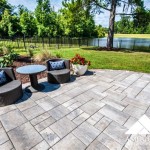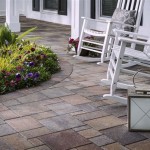How to Lay Patio Pavers with Gravel In Between
Creating an attractive and functional outdoor space often involves the installation of a patio. Patio pavers offer a versatile and aesthetically pleasing solution, and incorporating gravel between the pavers provides additional benefits, including enhanced drainage and a natural, rustic appearance. This article provides a comprehensive guide on how to lay patio pavers with gravel in between, outlining the necessary steps for a successful installation.
Planning and Preparation
Before embarking on the physical installation, a thorough planning phase is crucial. This involves determining the patio's size and shape, selecting appropriate pavers and gravel, and understanding the site's existing conditions.
The first step is to accurately measure the area designated for the patio. Consider the intended use of the space when determining the dimensions. A patio designed for outdoor dining will require more space than one intended solely for relaxation. Mark the perimeter of the patio area using stakes and string, ensuring that all corners are square and the lines are straight. Employ a measuring tape and a builder's square to achieve accurate measurements. The string lines will serve as a visual guide throughout the excavation and leveling process.
Choosing the right pavers is essential for both the aesthetic appeal and the durability of the patio. Pavers are available in a wide variety of materials, including concrete, brick, natural stone, and porcelain. Each material offers different characteristics in terms of appearance, cost, and maintenance requirements. Concrete pavers are a popular choice due to their affordability and versatility. Brick pavers provide a classic, traditional look, while natural stone pavers offer a unique, organic feel. Porcelain pavers are known for their durability and resistance to staining. The size and shape of the pavers should also be considered in relation to the overall design and the desired aesthetic. Smaller pavers tend to create a more intricate and detailed pattern, while larger pavers can provide a more streamlined and modern appearance. Calculate the number of pavers needed based on the area of the patio and the dimensions of the chosen paver.
Selecting the appropriate gravel is equally important. The gravel used between the pavers should be small enough to fill the gaps effectively but large enough to provide adequate drainage. Pea gravel, decomposed granite, and crushed stone are common choices. Pea gravel offers a smooth, rounded texture, while decomposed granite provides a more rustic, earthy appearance. Crushed stone is a durable and cost-effective option. Consider the color and texture of the gravel in relation to the pavers to create a cohesive and visually appealing design. The gravel also serves as a leveling agent and helps to prevent weeds from growing between the pavers. It needs to be stable to avoid shifting and unevenness over time.
Assessing the existing ground conditions is crucial for ensuring proper drainage and stability. If the ground is sloped, it may need to be leveled to create a flat surface for the patio. Check for underground utilities, such as pipes and cables, before beginning any excavation. Contact the local utility companies to locate and mark any underground lines in the area. This will prevent accidental damage during the excavation process. Consider the soil type and its drainage characteristics. If the soil is heavy clay, it may be necessary to improve drainage by adding a layer of gravel or installing a drainage system.
Excavation, Base Preparation, and Leveling
Proper excavation, base preparation, and leveling are essential for a stable and long-lasting patio. These steps ensure that the pavers are laid on a solid foundation, preventing settling and shifting over time.
Begin by excavating the area within the marked perimeter. The depth of the excavation will depend on the thickness of the pavers, the base material, and the desired finished height of the patio. Generally, excavate to a depth of at least 6-8 inches. This allows for a 4-inch gravel base and a 2-inch sand setting bed, plus the thickness of the pavers. Use a shovel and a wheelbarrow to remove the excavated soil. Ensure that the excavation is uniform in depth across the entire area. Use a laser level or a spirit level to check the depth and ensure that the surface is level. If the soil is unstable or contains organic matter, it may be necessary to excavate deeper and replace the soil with compacted gravel.
After excavation, install a weed barrier fabric over the exposed soil. This fabric will prevent weeds from growing up through the pavers and gravel. Overlap the edges of the fabric by at least 6 inches and secure it with landscape staples. The weed barrier fabric should be durable and resistant to tearing. It should also allow water to drain through, preventing water from pooling beneath the pavers.
Next, install the gravel base. This layer provides a stable and well-draining foundation for the pavers. Use crushed gravel for the base material. Spread the gravel evenly over the weed barrier fabric to a depth of approximately 4 inches. Compact the gravel using a plate compactor. This will ensure that the gravel is tightly packed and provides a solid base. Compact the gravel in several passes, overlapping each pass by at least 6 inches. The plate compactor should be suitable for compacting gravel. Refer to the manufacturer's instructions for proper operation.
After compacting the gravel base, add a layer of sand as a setting bed for the pavers. Use coarse sand for the setting bed. Spread the sand evenly over the gravel base to a depth of approximately 2 inches. Use a screed board to level the sand. A screed board is a long, straight piece of wood or metal that is used to level the sand to a uniform depth. Pull the screed board across the sand, using the string lines as a guide. Remove any excess sand and fill in any low spots. The sand should be level and smooth, without any bumps or dips. Avoid walking on the leveled sand, as this can create unevenness. If necessary, use a kneeling board to distribute your weight while working on the sand bed.
Paver Installation, Gravel Filling, and Compaction
With the base properly prepared, the pavers can be laid. It is crucial to lay the pavers accurately and consistently to achieve a professional-looking result. The final step involves filling the gaps between the pavers with gravel and compacting the entire surface.
Begin laying the pavers along one edge of the patio area, using the string lines as a guide. Place each paver carefully on the prepared sand bed, ensuring that it is level and aligned with the adjacent pavers. Use a rubber mallet to gently tap each paver into place. This will help to ensure that the paver is firmly seated in the sand and is level with the surrounding pavers. Maintain a consistent spacing between the pavers to allow for the gravel infill. The spacing should be uniform and consistent throughout the patio. Use paver spacers to maintain consistent spacing between the pavers. Paver spacers are small plastic or metal devices that are placed between the pavers to ensure uniform spacing. Check the level of each paver as it is laid, using a spirit level. If a paver is not level, add or remove sand beneath the paver as needed.
Continue laying the pavers in rows, working your way across the patio area. As you lay the pavers, check the alignment and spacing regularly. Make any necessary adjustments to ensure that the pavers are properly aligned and spaced. If you need to cut pavers to fit around obstacles or along the edges of the patio, use a paver cutter or a wet saw. A paver cutter is a hand-operated tool that is used to cut pavers. A wet saw is a power tool that uses a diamond blade to cut pavers. Wear safety glasses and gloves when using a paver cutter or a wet saw. Ensure the cuts are clean and precise.
Once all the pavers have been laid, fill the gaps between the pavers with gravel. Use a shovel or a trowel to spread the gravel evenly over the patio surface. Sweep the gravel into the gaps between the pavers, using a broom or a brush. Ensure that the gaps are completely filled with gravel. Add more gravel as needed to fill any voids. Avoid overfilling the gaps, as this can make the patio uneven. The gravel should be level with the surface of the pavers. Rake or sweep the gravel to create an even surface. The gravel should be uniformly distributed between the pavers.
After filling the gaps with gravel, compact the entire patio surface using a plate compactor. This will help to seat the pavers firmly in the sand bed and to lock the gravel in place. Use a plate compactor with a rubber mat attachment to prevent scratching or damaging the pavers. Compact the patio surface in several passes, overlapping each pass by at least 6 inches. The plate compactor should be suitable for compacting pavers. Refer to the manufacturer's instructions for proper operation. After compacting the patio surface, add more gravel to any gaps that have settled. Sweep the patio surface clean to remove any excess gravel or sand.

Diy Pea Gravel Patio With Pavers Love Renovations

Diy Pea Gravel Patio With Pavers Love Renovations

How To Make A Modern Patio With Pavers Pea Gravel The Savvy Heart Interior Design Décor And Diy

How To Diy A Concrete Paver Pea Gravel Patio The Collected House

How To Build A Diy Patio For Under 120 Outdoor Spaces

How To Diy A Concrete Paver Pea Gravel Patio The Collected House

Diy Pea Gravel Patio With Pavers Love Renovations

How To Lay Stepping Stones On Gravel In Simple Steps

Installing A Diy Paver Patio Is The Ultimate Spring Project

Almost Done Paver Patio Diy 12x12 Pavers With Gravel Between Design
Related Posts








